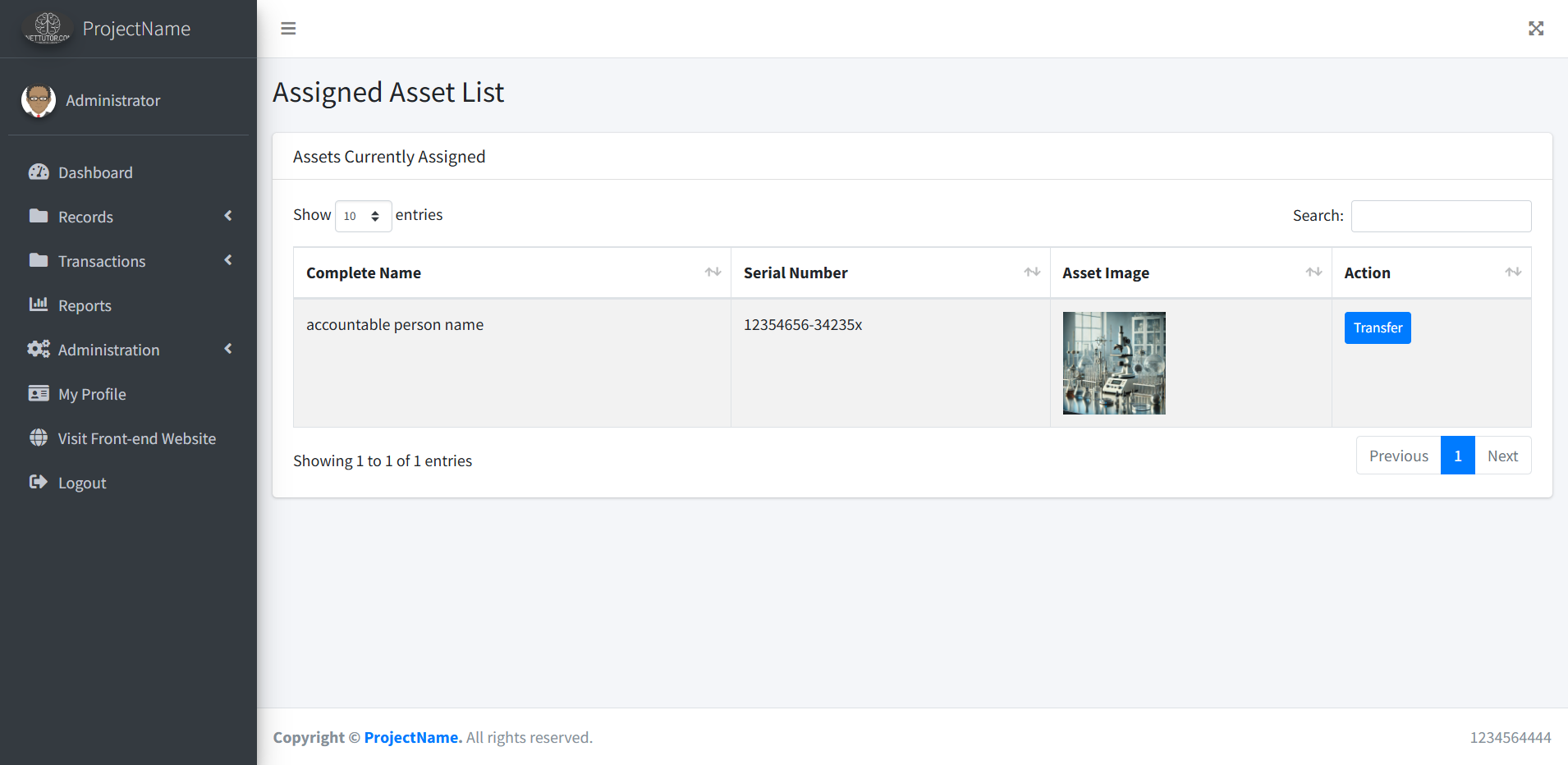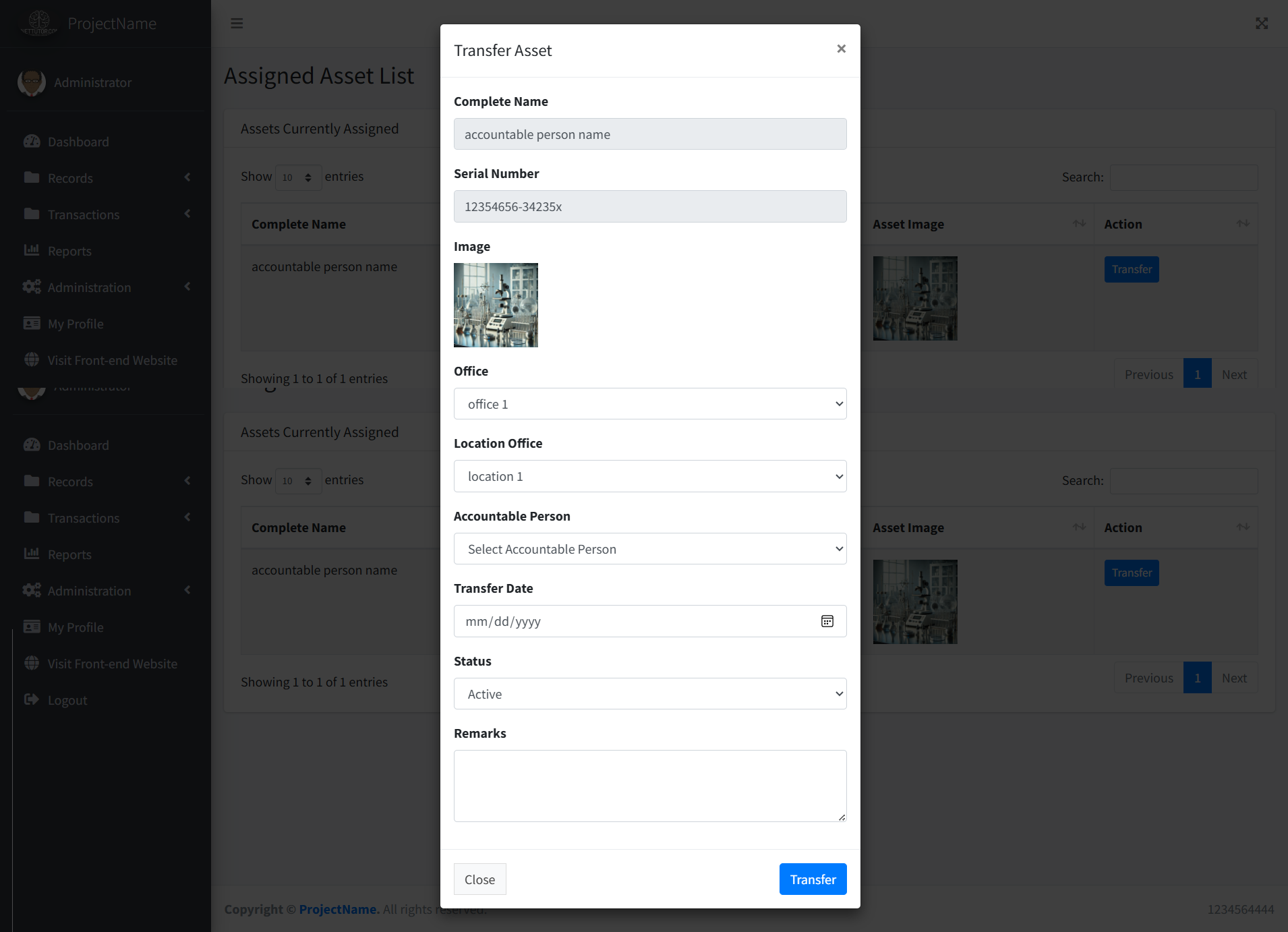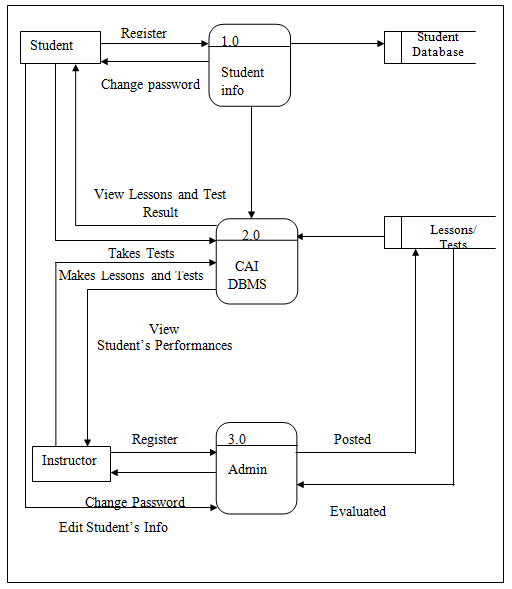School Asset Inventory Asset Transfer Module
Overview of the Asset Transfer Module
Table of Contents
The Asset Transfer Module is a key feature within the School Asset Inventory system, designed to facilitate the transfer of asset accountability from one person to another. This module ensures that assets are efficiently and accurately tracked as they change hands, allowing schools or organizations to maintain clear records of who is responsible for each asset at any time.
This transfer functionality enables smooth transitions in asset ownership, whether it’s for reassigning equipment, relocating an asset to a new office, or updating records as assets move within the organization. By recording every transfer in detail, the module strengthens accountability and transparency, making it easier to monitor asset location, status, and responsible persons.
Setting Up the Folder Structure
To effectively manage asset transfers, the transfer directory is organized into a clear and functional folder structure. Here’s a breakdown of the files and folders within this module, each with a specific purpose in handling asset transfers:
- Folder Layout:
- The transfer directory includes core pages and a function folder for processing asset transfers.
- assigned_list.php:
- This page lists all assets currently assigned and available for transfer. Users can view a table showing the asset’s details (like the serial number and image) along with a transfer button for each entry. This button opens a modal where the transfer process can be initiated.
- transfer_modal.php:
- This modal contains a form used to initiate the asset transfer. It displays important fields such as the asset’s current owner, location, and the date of transfer. Dropdown options allow the user to select the new responsible person, office, and other relevant details before confirming the transfer.
- Function Folder:
- transferAction.php: This file contains the backend logic needed to process asset transfers. When a user submits the transfer form, transferAction.php updates the asset’s information in the database, saving the transfer record and updating relevant fields to reflect the new owner, office, and location.
This structured setup ensures a streamlined process for asset transfers, helping maintain accurate and up-to-date asset accountability.
Assigned List Page (assigned_list.php)
The Assigned List Page is a key part of the Asset Transfer Module, designed to make asset tracking and reassignment easy within the inventory system.
- Purpose:
- The assigned_list.php page displays all assets currently assigned to users, pulling data directly from tbl_assignment. This page enables administrators or asset managers to view assigned assets and quickly access the transfer option for reassigning accountability to another user.
- Fields and Features:
- Table Columns:
- The table on this page displays key details of each assigned asset, including:
- complete_name: Shows the name of the user currently responsible for the asset.
- serial_number: Lists the asset’s unique serial number for easy identification.
- asset_image: Provides a visual reference of the asset with an image display.
- Transfer Button: For each asset, there is a transfer button, making it easy to initiate the transfer process.
- The table on this page displays key details of each assigned asset, including:
- Transfer Button:
- The Transfer Button opens the transfer modal where users can complete the reassignment process. This button allows administrators to seamlessly transition the asset to a new user by capturing necessary details, such as new accountable person, updated location, and transfer date.
- Table Columns:
This layout and functionality of the Assigned List Page ensure that all assigned assets are visible in one place, with quick access to initiate transfers, making it a vital tool for managing and tracking assets effectively.
Transfer Modal (transfer_modal.php)
The Transfer Modal serves as a convenient pop-up form that lets users reassign assets from one individual to another within the inventory system, enhancing asset accountability and management.
- Purpose:
- The transfer_modal.php is designed for quick and efficient asset transfers. It enables administrators to update the assignment details of assets by transferring accountability to a new user, keeping the asset records accurate and up-to-date.
- Fields in the Modal:
- complete_name: Displays the name of the current user accountable for the asset, giving clarity on who currently holds responsibility.
- serial_number: Shows the asset’s unique serial number for identification, ensuring accuracy during the transfer.
- Image: A visual display of the asset image helps verify the correct asset is being transferred.
- Dropdowns:
- Office & Location Office: These dropdowns are pre-filled with the asset’s currently assigned office, allowing users to change office assignments if needed.
- Transfer Date: An input field where users can enter the transfer date, keeping a clear timeline of asset reassignments.
- Status: A dropdown with options such as:
- Active: Indicates the asset is currently in use.
- Returned: Shows that the asset has been returned.
- Disposed: Used for assets that are no longer in use.
- Maintenance: Shows if the asset is under maintenance.
- Remarks: An optional field for adding notes about the transfer, useful for additional context or instructions.
- Transfer Button: Saves the transfer details to tbl_transfer and updates tbl_assignment with the new accountable person, office, location, and date, ensuring that the asset’s assignment records are current.
This Transfer Modal improves asset management by allowing quick, recorded updates of asset accountability, ensuring the system stays organized and accurate with each transfer.
Implementing the Transfer Logic (transferAction.php)
The transferAction.php script is essential to updating asset records in the database during a transfer. This file contains the logic that updates tbl_assignment with details of the new accountable person, location, and transfer date, ensuring the asset inventory reflects the latest assignment information.
Update Logic Steps:
- Capture and Validate Transfer Data:
First, the script collects data from the transfer modal form, such as the new accountable person’s ID, updated office location, transfer date, and any remarks. It performs validation to ensure all necessary fields are completed accurately. - Update tbl_assignment:
The script then updates tbl_assignment with the new assignment information:- accountable_person_id is set to the ID of the new person responsible for the asset.
- office_id and location_id are updated if the asset’s office or location changes as part of the transfer.
- assignment_date is changed to the transfer date, reflecting when the new assignment takes effect.
- remarks are appended, adding any relevant transfer notes for record-keeping.
- Record Transfer in tbl_transfer:
A new entry is created in tbl_transfer to log the transfer details. This record includes the previous and new accountable persons and transfer date, creating a historical log that documents each transfer. - Execute and Confirm:
Once the database updates are completed, the script returns a confirmation message or redirect, signaling that the transfer was successful.
Benefits of this Logic
This transfer logic keeps asset assignments current and documented. By updating tbl_assignment and tbl_transfer simultaneously, this process supports transparent, trackable asset transfers that improve accountability and management across the organization.
Database Structure
The database structure in the Asset Transfer Module is key to tracking and documenting asset transfers. Two primary tables, tbl_transfer and tbl_assignment, work together to maintain a complete history and current assignment details for each asset.
- tbl_transfer:
This table is dedicated to recording each instance of asset accountability transfers, creating a historical log that provides insights into asset movement over time.- Columns:
- transfer_id: Unique identifier for each transfer record.
- assignment_id: Links to the original assignment record in tbl_assignment for easy reference.
- accountable_person_id_from: ID of the person currently accountable for the asset, indicating the previous asset holder.
- accountable_person_id_to: ID of the person to whom the asset is being transferred.
- transfer_date: Date when the asset accountability transfer occurs, helping maintain a timeline of asset movements.
- status: Indicates the asset’s current state (options include active, returned, disposed, maintenance), making it easier to track asset condition.
- remarks: Field for any notes or context about the transfer, which can be helpful for documenting additional details.
- Columns:
- tbl_assignment:
After each transfer, this table is updated with new assignment information, ensuring that the asset’s current accountability is accurately reflected in the system.- Updated Columns:
- accountable_person_id: Updated to show the new accountable person’s ID.
- office_id: Modified to reflect any changes in the office where the asset is now assigned.
- location_id: Updated if the asset’s location changes as part of the transfer.
- assignment_date: Set to the latest date of transfer to mark the new assignment.
- remarks: New notes are appended, allowing for detailed tracking of each reassignment.
- Updated Columns:
This database structure supports effective asset tracking by ensuring that current assignments and historical records are clear and accessible, promoting accountability and streamlined asset management.
Source Code and Demonstration


Summary
The Asset Transfer Module is a crucial addition to the asset inventory system, providing a structured way to transfer asset accountability between individuals within an organization. By enabling easy reassignment of assets, this module ensures that each asset’s location, responsible person, and assignment details are always up to date.
Key Benefits:
- Improved Asset Tracking: This module records every transfer, maintaining a clear log of asset history. By keeping track of each asset’s location and accountability changes, it enhances asset transparency across the organization.
- Enhanced Accountability: Detailed records in tbl_transfer make it easy to review who held responsibility for any asset at a given time, promoting a culture of accountability.
- Efficient Management: With an intuitive interface and streamlined transfer process, the module simplifies asset management tasks, making it easy for administrators to ensure accurate records and minimize lost or misplaced assets.
Overall, the Asset Transfer Module is an essential tool for maintaining up-to-date, detailed asset records, which ultimately strengthens accountability and optimizes the asset management process.
Previous Tutorial:


